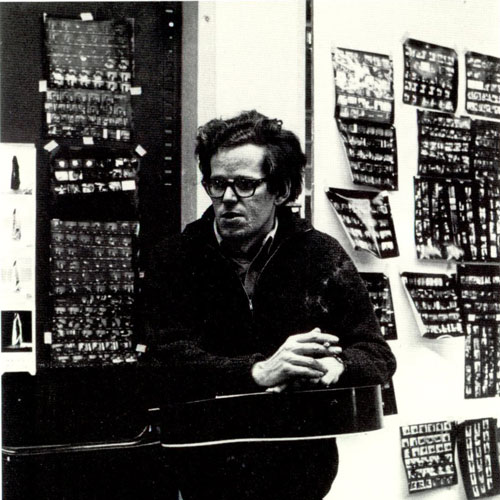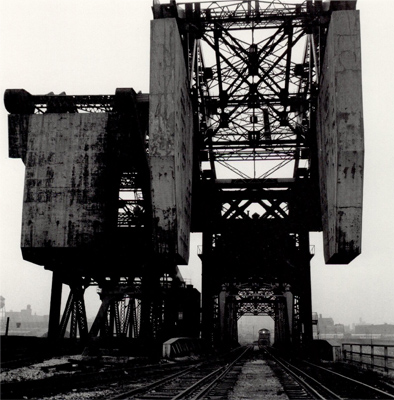Exhibitions
ABOUT THE EXHIBITION
A photograph exists first as a negative image on film from which a positive print is produced. The negative state of the image can also be presented in print form. I have been exploring the positive and negative states of the photographic image and their simultaneous and coherent presentation in a single photographic print. The changes from positive to negative are controlled by a second image which acts as a catalyst. I have been refining techniques to accomplish this end as well as investigating how this new system for ordering visual information changes the “language” of photography.
—Robert Stiegler
This retrospective spans approximately thirty years of Robert Stiegler’s photographic and film work, encompassing many projects involving different techniques. Some of these works have been seen in Chicago in small groups over the years; this exhibit is the first time they are shown together.
Stiegler, a native of Chicago, received a BFA and an MFA from the Institute of Design at the Illinois lnstitute of Technology, where he studied with Aaron Siskind and Arthur Siegel. He taught at the University of Illinois at Chicago in the School of Art and Design from 1966 until his death in 1990. Stiegler received grants from the National Endowment for the Arts and the Illinois Arts Council. His work is in public and private collections, including the Art Institute of Chicago, the Museum of Modern Art, New York, and the George Eastman House, Rochester.
The exhibition includes examples from different bodies of his photographic work and some of his films, such as his humorous dog show images and widelux views as well as his many series of complex positive/negative works. These latter works involve a complex layering of photographic information in positive and negative form that investigate, as Stiegler said, “the dual nature of the photographic process,” where “concerns shift from the literal to the abstract.”
Stiegler’s interest in photography began at Lane Tech, where he was encouraged by a teacher to attend the lnstitute of Design in Chicago and study with photographers Harry Callahan and Aaron Siskind. After serving in the Army in Germany, he worked for photographer-filmmaker Vince Maselli and then for Morton Goldsholl Design creating photography and film. Stiegler also produced his own short films in response to re-entering civilian life. He began teaching at UIC in its second year (1966); he was instrumental in establishing the photography curriculum, and he developed the studio course and the first direction of documentary photography. While teaching he completed an MFA at the Institute of Design (1968–70) with Arthur Siegel, creating photo-silkscreen interpretations of a series of his “bridge” pictures.
Stiegler was part of the “original” faculty of the UIC School of Art and Design and was instrumental in making the school what it is today. He was widely known among the faculty for having contributed to the development of the curriculum and to a careful scrutiny of the details involved in reconfiguring the studio courses to conform to the semester system. He and his wife, Anita David, were prominent in the Chicago art community as artists and through their lively and active relationships with other artists. Stiegler was a founding member of the Center Cinema Co-op at the Art Institute of Chicago; he shared in the running of Lightfall Gallery in Evanston; he was part of a group who presented films at the Little Stabs of Happiness Cinemateque; and he was an artist-member of Live from Chicago cooperative gallery, one of Chicago’s first. At UIC he started the New Works gallery, which continues to be a vital part of the MFA photography program.
Stiegler’s photographs range from straightforward work in which the often-centered subject dominates his concern, to an exploitation of panoramic views made in Chicago and during travels to Florida, the western United States, Niagara Falls, Egypt, and Great Britain. The most unique of his works are the product of a composite printing system in which one image becomes a “mask” for another. These pictures often have subjects of their own—the cacti and especially many of the Egypt views. During his 1983–84 sabbatical, he added color to this positive/negative work and found “the work became baroque and contrapuntal rather than integrated and harmonious,” suggesting new strategies and resulting in images unlike any he’d made previously. Steigler’s health began to fail during a period in which he was refining his multiple-enlarger system. He was preparing to expand on his most recent color work when he died of cancer on January 18,1990.
PRINT COLLATERAL

Robert Stiegler
Catalog essay by Michael Weinstein
Gallery 400, School of Art and Design,
University of Illinois at Chicago, 1992
21 pp., 8 x 11 in., with black and white reproductions
This catalogue can be purchased for $10.00 plus shipping by calling Gallery 400 at 312 996 6114.
ARTIST BIOGRAPHY
 Robert Stiegler (1930–1990) was a photographer and filmmaker from in Chicago, Illinois. A lifelong Chicagoan, he concentrated during the period of 1956–60 on making photographs largely of local bridges. For his master’s thesis at Illinois Institute of Technology, he worked primarily with photo-silkscreening. His other areas of artistic interest included street documentary, nature photography, and positive-negative abstractions. He taught at the University of Illinois at Chicago, where he helped to develop the photography program, from 1966 until his death in 1990. Stiegler received numerous grants, including from the National Endowment for the Arts and the Illinois Arts Council. His work is held in the collections of the Art Institute of Chicago and the Museum of Modern Art, New York, among others. He completed a BFA (1960) at the Institute of Design at the Illinois Institute of Technology in Chicago, studying with Harry Callahan and Aaron Siskind. He returned to the Institute of Design to complete an MFA in 1970.
Robert Stiegler (1930–1990) was a photographer and filmmaker from in Chicago, Illinois. A lifelong Chicagoan, he concentrated during the period of 1956–60 on making photographs largely of local bridges. For his master’s thesis at Illinois Institute of Technology, he worked primarily with photo-silkscreening. His other areas of artistic interest included street documentary, nature photography, and positive-negative abstractions. He taught at the University of Illinois at Chicago, where he helped to develop the photography program, from 1966 until his death in 1990. Stiegler received numerous grants, including from the National Endowment for the Arts and the Illinois Arts Council. His work is held in the collections of the Art Institute of Chicago and the Museum of Modern Art, New York, among others. He completed a BFA (1960) at the Institute of Design at the Illinois Institute of Technology in Chicago, studying with Harry Callahan and Aaron Siskind. He returned to the Institute of Design to complete an MFA in 1970.
ARTISTS
Robert Stiegler
SUPPORT
Robert Stiegler Retrospective 1938–1990 is supported by the University of Illinois Chicago School of Art and Design’s College of Architecture, Art, and Urban Planning.
This exhibition is also partly supported by a grant from the Illinois Arts Council, a state agency, and the National Endowment for the Arts.





